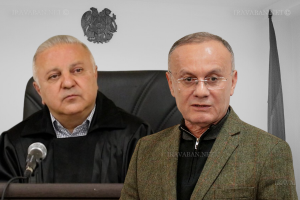Judiciary is brought to life by the administration of justice, which is administered by judges, and each judge administers justice in his own case, being independent, based solely on his own internal convictions, the Constitution and the laws.
Hovik Shahnazaryan Judge of the Court of General Jurisdiction of the city of Yerevan said this in a conversation with Iravaban.net, talking about the goals related to the judicial system in the Judicial and Legal Reform Strategy.
“Why do I say this? Because, in my opinion, the theme of ‘the judiciary is free from corruption and patronage’ is directly related to the personal qualities and integrity of judges, as the judiciary is a complete system of judges endowed with independent, impartial and hierarchical order,” the judge mentioned.
In his opinion, it is impossible to speak objectively about the authority of the judiciary and the trust it has in it, apart from the assessment of the qualities of each judge.
“Because most of the judges in power today have done their duty of justice before the strategy was developed and still continue to do so, and given that, if I am not mistaken, we have only had one or two cases since the strategy was developed, when perhaps based on the facts that have not been finally evaluated in court, possible manifestations of corruption by the judges have been registered, we can only conclude that there have been no visible and expected changes in the strategy action plan. Such separate manifestations occur with the same frequency in the most developed countries, including the USA and European countries, but in my opinion, the most important problem in this field in any country is the lack of systemic corruption and patronage, and in my opinion, there is currently no systemic corruption and patronage in the judiciary of our country” the judge said.
According to Hovik Shahnazaryan, in order to achieve results in the fight against such vicious phenomena, strategic programs are not so important as their actual use for the set goals. For example, if a mechanism for evaluating judges is introduced, it is not primarily important whether those mechanisms or criteria are introduced and the body that implements them is established within the timeframe set by the strategy, it is important whether you achieve that goal or not, in particular, is there any implementation of cases when judges who are not professional in the system and do not correspond to their positions are fairly identified, and most dangerously, when the mechanisms introduced to combat the vicious phenomena within the framework of the program, to improve the quality of independence and impartiality of the judiciary, can serve completely different purposes.
“The most important and priority step that should have been taken within the framework of this strategy was to improve the financial and social situation of judges, including the sharp increase in the salary of judges, which has not happened so far. In my opinion, this issue should have been resolved first, and until this issue is resolved, the other measures envisaged by the program will not be able to fully serve their objective and be implemented. Proof of this is the desire of well-respected and reputable judges to leave the system and go to work in the private sector, by the way, with the realistic expectation of being paid several times more and doing ten or more times less. It follows from what I said that: As long as we cannot keep and appreciate the existing good, we cannot build anything new or at least the newly built will not have solid foundations,” the judge said.
According to him, in order to strengthen the independence of the judiciary, it is necessary to expand the powers of the General Assembly of Judges, and the powers enshrined in the Constitutional Law “Judicial Code” and, first of all, to introduce mechanisms not to build a barrier between them that will weaken the judiciary.
One of the strategic directions of the judicial and legal reform strategy is the introduction of bases and procedures in accordance with international standards for calling the judges and members of the Supreme Judicial Council to disciplinary responsibility.
Speaking about this, the judge detailed, “As a member of the Ethics and Disciplinary Committee of the General Assembly of Judges, I consider it very important to include in the strategy program the inclusion of two non-judge members in the committee. Truly, at first this news was not unequivocally perceived by the judges, to be honest, I was also skeptical about this change, but for more than a year and a half as a result of joint work with non-judge members Davit Hakobyan, Suzanna Soghomonyan and now Harutyun Harutyunyan I came to the conclusion that it was the right move. Because this amendment not only removed the doubts about the accountability of the judiciary in the process of calling the judges to disciplinary responsibility and now also fully ensures the transparency of the process of instituting disciplinary proceedings against judges. The Committee also addressed some issues, taking into account the experience, knowledge and approaches of the non-judicial members, which stems from the experience directly from the public and as a result of more open communication with the public, knowledge and approaches of the private sector.
In other words, the opinion voiced before this change that the previous procedure poses a threat to the corporate approach to instituting disciplinary proceedings against judges no longer has anything to do with reality. By the way, this was also mentioned by the Venice Commission, that is, at present the two non-judicial members of the committee, among others, unequivocally solve the problem of transparency of the committee’s work by their operational significance of “public watchdog”.
According to Shahnazaryan, the above-mentioned positive change should have been followed by the termination of the authority of the Minister of Justice’s to initiate disciplinary proceedings, especially at a time when the work of the committee’s professional staff is visible and we have very negative reports from international organizations. In Opinion N18 of October 2017 (see p. 136), the Venice Commission noted that the Ethics and Disciplinary Committee of the General Assembly of Judges has a more diverse composition than its predecessor, suggesting that the Minister may be phased out after launch of the new system, therefore proposed to reconsider the role of the Ministry of Justice in disciplinary proceedings against judges, and GRECO in its second report of 12 December 2019. GrecoRC4 (2019) 21 regrets that the Minister of Justice still has this function and that GRECO’s position remains that the role of the Minister of Justice in the disciplinary proceedings should be terminated.
“I do not agree at all with the considerations of conditioning the quality of the Committee’s work with the number of disciplinary proceedings initiated and sent to the SJC, and I want to emphasize that the quality of the Committee’s work cannot be conditioned by the mathematical arithmetic of disciplinary proceedings and submitting motions to the Supreme Judicial Council., and we must acknowledge that judges are not the subjects against whom the number of disciplinary proceedings instituted, regardless of the quality of the grounds for instituting proceedings, can contribute to the strengthening of an independent and impartial judiciary, and we must acknowledge the fact that unreasonably terminated or dismissed proceedings are, nevertheless, in the objective reality themselves instruments of indirect interference with the judiciary, so a maximally professional and sensitive approach must be taken to this issue, which can be achieved only with a qualified staff of the collegial body, and the reports of international structures are built on this logic: that is on the termination of the powers of the Minister after the formation of the new composition of the Committee. At first glance, it seems that the rejection of the request for disciplinary action or the termination of the proceedings does not have a negative impact on the judge’s activities, but in reality, it certainly worries the judge, especially in the condition of such a busy schedule, when sometimes without days off and apart from working long hours, there is also an increased risk of personal liability and feelings of underestimation of work, which simply cannot but affect the quality and efficiency of a judge’s work,” he said.
The judge also pointed out that the legislation on initiating disciplinary proceedings and its conduct ignores the fact that the bodies that initiate the proceeding, having the same powers, have the same goals, that is, not only the principle of respect for the decision made by each of them, but also the principle of respect and the presumption that each decision is lawful.
“In the above-mentioned sense, I have a very negative attitude towards the legislative possibility, through which judges can be twice targeted for proceedings for the same act initiated by two authorized bodies. It is one thing when a person’s report is examined and resolved positively or negatively by one of the prosecuting authorities, it is another thing when the same issue can be examined by two prosecuting authorities at the same time, in sequence.
Thus, as a result of a change in the strategic action plan, the prosecuting authority terminates the disciplinary proceedings if the same prosecuting authority has not previously instituted disciplinary proceedings against the same person or terminated the disciplinary proceedings.
What happens? The decision made by a body serving the same legitimate purposes is called into question by another body serving the same legitimate purposes and values. In my opinion, this is a settlement that contradicts all the requirements of the principle of legal certainty and the prohibition of double examination for the same act and violates the principle of the independence of the judge.
In my opinion, if the report on the judge is processed by a body with such authority, then, just as the purpose of the legislative regulation on the suspension of the examination of the same issue in the proceedings of the other body is the same, the decision given by that body should be final. Otherwise, we may have two conflicting decisions on the same issue concerning the same judge, and in that case no decision from the point of view of an impartial observer can ensure the criteria of fairness and objectivity. For example, we may encounter a situation where the Committee makes a decision to terminate the initiated proceedings, after which the Minister initiates proceedings and then submits a motion to SJC with request to hold the judge accountable, in the case when that decision was made not by one person but by the Committee in the composition of six judges, two law scientists, and it may happen vice versa.
“Assess for yourself: Whether such a situation is in line with the requirements of a democratic society and the rule of law? And in this case, is the probability of a possible influence on the judiciary neutralized? And whether in this conditions such a possibility guarantees the independence of the judge and excludes indirect interference in his affairs?” Hovik Shahnazaryan details.
To the question whether the grounds for initiating disciplinary proceeding against judges were commensurate with the purpose of overcoming corruption, he answered that initiate disciplinary proceedings based on the issues identified by the judges as a result of the analysis of the declaration of property, income and interests from the point of view of comprehensive evaluation of the judge’s integrity, if necessary, is a welcome step, in the sense that on this basis a judge may be subject to disciplinary action by a body with professional knowledge in the field; as the other two prosecuting authorities do not have the details of such information and professional knowledge in the field.
“It is especially important for the Commission for the Prevention of Corruption to emphasize the scope of initiating proceedings in accordance with the requirements and order provided by the Code and the Law on the Commission for the Prevention of Corruption. I do not consider it superfluous to mention that both during the change and in the past, judges have always resorted to integrity by publishing the information mentioned in their declarations, and if the public had suspicions about it, the other two bodies could have reported a violation of the judge’s code of conduct based on the report.
At the same time, I share the approach proven in international practice that violations related to the declaration of property are more serious disciplinary violations, which can lead to the termination of a judge’s powers, and a more specialized body should deal with this issue, through which it can be more effective to achieve the goals set by the strategy. It is especially important to emphasize that in this proceeding the judge is given the opportunity to substantiate the possible misstatement or the fact that the change of property took place with legal income, which I consider an important guarantee of the protection of the judge’s rights,” he said.
The Judicial and Legal Reform Strategy also envisages that steps should be taken to increase the public’s perception of the role of the judiciary and to increase its trust in it.
According to him, one of the guarantees of the Strategy in terms of public perception of the role of the judiciary and increasing its trust was to encourage the entry of leading specialists in the field. However but the reality is that examinations for feeling in the vacancies for judges are constantly being announced, and a relatively small number of lawyers are willing to become judges. Moreover, most of them do not even pass the stage of solving the written test tasks without scoring the minimum points, while in the past the written exam was more difficult because the written exam did not assume the correct answers of the pre-existing test.
“This shows that the judiciary has lost its attractiveness in terms of staffing, and mainly non-professional staff want to become judges. The reasons for this are the lack of sufficient social and financial guarantees for judges, overload, etc. Therefore, we cannot record that this goal of the program has been achieved. This is really something to think about, and the effectiveness of the implementation of the principles underlying the strategy will largely depend on the quality of the solution of this issue,” Shahnazaryan said.
Referring to the cooperation and effective communication between the judiciary and the public, the judge noted that he could not record any progress and there were no visible steps for him.
“On the contrary, instead of publishing and positively assessing the positive developments in the judiciary, in reality, especially in the media, there is often information with subjective assessments that do not reflect the real and fair assessment of the judges currently in power. I do not consider it correct to have a negative attitude towards the quality of justice done by a judge depending on the outcome of a judicial act, because the outcome of justice will always be unfavorable for one of the parties and therefore subjectively unacceptable for that party. Assessment of the independence and quality of the judiciary by such criteria will always be subjective and will not ensure the expected objective result of public confidence in the judiciary,” Shahnazaryan said.
Regarding the distribution of court cases and the change in workload, the judge noted that it was planned to increase the number of judges and assistant judges, to introduce effective alternative dispute resolution tools, including electronic tools, as well as to introduce and actively use e-government systems.
“As a judge examining civil cases, I can say that I have not noticed any changes in the first part, in particular, since the adoption of the strategy, no judge considering the civil cases has been added to the civil court of first instance in Yerevan, especially the number of assistant judges.
No significant steps have been taken to implement effective alternative dispute resolution, including electronic tools. I would like to mention that e-justice tools have been introduced only for payment order cases. By the way, Judge H. Zargaryan and I were involved by the SJC as judges in the process of creating that system. In my opinion, this system has significantly reduced the burden on the staff of the court with payment orders, which is evidenced by the positive feedback from judges. However, with many other similar cases, including special litigation, simplified proceedings, e-Justice tools, e-government systems have not been introduced so far, I do not know whether work is being done in that direction or not,” the judge said.
He notes that there has been no electronic distribution of cases through the program for a long time, due to the already published and well-known reasons, and since the assignment is made by the President of the court, there will always be reasonable doubts about ensuring an objective criterion in this process. “Given the goals of creating this system and the impossibility of implementing them at present, moreover, it is not possible to distribute the cases equally with the accuracy with which it can be organized through a computer program.”
According to Hovik Shahnazaryan, the judges were not relieved in terms of workload, especially him.
“Since, according to the decision of the SJC, I am also considered a judge examining cases of confiscation of property of illicite origin and in addition to the main civil cases, I also additionally examine these cases, without a corresponding reduction in the proportion of other cases.
I also considered important the idea of abolishing the authority to issue a writ of execution initiated by the SJC and immediately enforcing the judicial act through the Compulsory Enforcement Service, which was discussed many times, and if I am not mistaken, a draft law was prepared through the working group. But the issues connected with computerization of the system did not allow it to be completed logically, which would significantly reduce the workload of the judge and his staff,” he said.
According to Judge Hovik Shahnazaryan’s conclusion, no significant and visible steps have been taken to alleviate the burden on judges, and the judiciary continues to work in an overloaded state with negative consequences, which logically leads to a violation of the principle of a reasonable time for the examination of cases, and consequently to a decline in public confidence in the judiciary, which is not due to the inaction or improper work of judges, but to the objective consequence of the current workload.


















